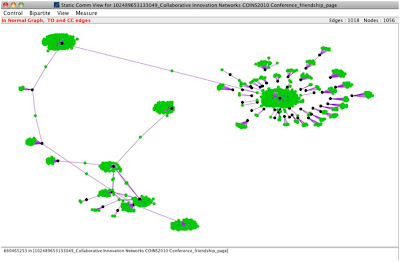Emotions Draw Close Friends: Analyzing the Social Network Structure of Facebook Fan Pages
Recently we were wondering if the social network structure of fans of a brand, a star, or a cause tells us how passionate the fans are. To be more precise, we were looking at the network structure of the friendship network of Facebook fan pages. This means that we collected – as far a publicly accessible – the friendship network of the people who clicked on the “like” button on a fan page.
For a start, look at the fan page of our own COINs2010 conference (by the way, the conference will be soon in Savannah Oct 7 to 9, at SCAD, we hope to see many of you there ☺ ).

The dark dots in the network are the fans of COINs2010, the green dots are their friends. This means that for this initial analysis we looked at how many and how well-connected friends a fan of COINs2010 has. We ignored direct links between the fans, but focused on their external friendship network.
In this first attempt we looked at a total of 15 fan groups in 5 categories, see the table below:

We (admittedly subjectively) ranked the emotionality from 1 (product brands) to 5 (medical causes). We found positive correlation of 0.33 (although non-significant) between the network density and emotionality. This means, the more connected the friends of a cause or brand are, the more emotional they are about their cause. Even more interestingly, we found significant negative correlation between the clustering coefficient of -0.57. This means that the more the friends of fans are clustered in subgroups, the less emotional they are.
The conclusions would be that the causes with the most emotional supporters have a dense, but evenly spread out network, with few clearly separated subgroups.
Based on this admittedly very preliminary analysis, what are actions you can take to further you cause? The answer is simple: Help to weave the network of your supporters.
1. broker connections between supporters
2. fight fragmentation of supporters by connecting subgroups
In short – help build one large happy familiy!
For a start, look at the fan page of our own COINs2010 conference (by the way, the conference will be soon in Savannah Oct 7 to 9, at SCAD, we hope to see many of you there ☺ ).

The dark dots in the network are the fans of COINs2010, the green dots are their friends. This means that for this initial analysis we looked at how many and how well-connected friends a fan of COINs2010 has. We ignored direct links between the fans, but focused on their external friendship network.
In this first attempt we looked at a total of 15 fan groups in 5 categories, see the table below:

We (admittedly subjectively) ranked the emotionality from 1 (product brands) to 5 (medical causes). We found positive correlation of 0.33 (although non-significant) between the network density and emotionality. This means, the more connected the friends of a cause or brand are, the more emotional they are about their cause. Even more interestingly, we found significant negative correlation between the clustering coefficient of -0.57. This means that the more the friends of fans are clustered in subgroups, the less emotional they are.
The conclusions would be that the causes with the most emotional supporters have a dense, but evenly spread out network, with few clearly separated subgroups.
Based on this admittedly very preliminary analysis, what are actions you can take to further you cause? The answer is simple: Help to weave the network of your supporters.
1. broker connections between supporters
2. fight fragmentation of supporters by connecting subgroups
In short – help build one large happy familiy!



Good
ReplyDeletecreative networks
I like this informative article. Thank you very much for providing this kind of information.Keep it up !
ReplyDeletecreative networks
Social Networks are becoming beneficial for SEO perspective too.
ReplyDeleteSocial Media Marketing